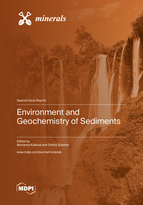Environment and Geochemistry of Sediments
A special issue of Minerals (ISSN 2075-163X). This special issue belongs to the section "Mineral Geochemistry and Geochronology".
Deadline for manuscript submissions: closed (15 July 2022) | Viewed by 18801
Special Issue Editors
Interests: geochemistry; radiocarbon dating; paleoclimatic reconstructions; lake sedimentation; petrography; XRF analysis; stable isotopes; mineralogy; geoecology
Special Issues, Collections and Topics in MDPI journals
Interests: paleoclimatology; geochemistry; geography; paleolimnology; lake sedimentogenesis; geomorphology; lithology; geoecology; marine geology
Special Issues, Collections and Topics in MDPI journals
Special Issue Information
Dear Colleagues,
The geochemical characteristics of environments can be developed from geochemical studies of sedimentary rocks. Different geochemical indicators can be used for paleoenvironmental reconstruction of processes of sedimentation. Trace and major elements in sedimentary rocks are extremely sensitive to paleoenvironmental changes, making them informative for studying the paleoclimate, paleoenvironment, as well as ancient and modern anthropogenic activity. The distribution of pollutants in sediments is important for modern geoecological processes. Isotopic research of sediments is essential for paleoreconstructions, geochronology, and ecology. We also welcome contributions that address the application of different analytic methods for the study of geochemistry and mineralogy of sediment processes.
For this Special Issue, we invite authors to submit papers on topics related to geochemistry, mineralogy, and geochronology of natural and anthropogenic sediments and environmental conditions of their formation.
Dr. Marianna Kulkova
Prof. Dr. Dmitry Subetto
Guest Editors
Manuscript Submission Information
Manuscripts should be submitted online at www.mdpi.com by registering and logging in to this website. Once you are registered, click here to go to the submission form. Manuscripts can be submitted until the deadline. All submissions that pass pre-check are peer-reviewed. Accepted papers will be published continuously in the journal (as soon as accepted) and will be listed together on the special issue website. Research articles, review articles as well as short communications are invited. For planned papers, a title and short abstract (about 100 words) can be sent to the Editorial Office for announcement on this website.
Submitted manuscripts should not have been published previously, nor be under consideration for publication elsewhere (except conference proceedings papers). All manuscripts are thoroughly refereed through a single-blind peer-review process. A guide for authors and other relevant information for submission of manuscripts is available on the Instructions for Authors page. Minerals is an international peer-reviewed open access monthly journal published by MDPI.
Please visit the Instructions for Authors page before submitting a manuscript. The Article Processing Charge (APC) for publication in this open access journal is 2400 CHF (Swiss Francs). Submitted papers should be well formatted and use good English. Authors may use MDPI's English editing service prior to publication or during author revisions.
Keywords
- geochemistry
- sediments
- paleoclimate
- pollution
- paleoenvironment
- geochronology
- isotopes
- geoecology
- anthropogenic activity
Related Special Issue
- Environment and Geochemistry of Sediments, 2nd Edition in Minerals (2 articles)






